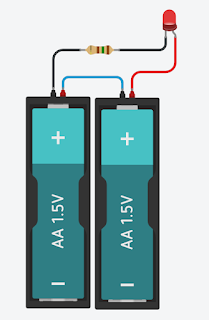Assume you have a 3 volt supply and wish to attach a single red LED to it.
What kind of resistor do we require?
We know that this wire is 3 volts and that this wire is 0 volts. Because the led has a voltage loss of about 2 volts, our resistor must eliminate the remaining 3 volts.
To get 1 volt, subtract 2 volts. Because the led requires around 20 milliamps of current, 1 volt divided by 0.02 amps equals 50 ohms of resistance. For this computation, make sure you convert your milliamps to amps. We have a calculator on our website where you can just enter your data to make it easy.
Now go ahead and attempt to solve this one before I post your answers in the comments area below.
Example
Let's imagine we have a 9-volt battery and wish to attach a yellow led that consumes 20 milliamps of current and has a voltage drop of 2 volts.
Current Limit Resistor Selection
How big of a resistor do you need? We have a 9-volt supply, so we deduct 2 volts for the led, leaving us with a 7-volt drop for the resistor. Because the current is 20 milliamps, the resistance is 350 ohms when 7 is divided by 0.02 amps.
The issue now is that we lack a 350-ohm resistor. Only 330 or 390 ohms are available. So, which should we go with? We must guarantee that the current does not exceed 20 milliamps, as we observed before.
To accomplish so, divide the needed voltage drop of 7 volts by the resistor value of 330 ohms to obtain 0.021 amps, then repeat for the 390-ohm resistor to obtain 0.018 amps. We may also combine resistors to obtain the exact value we want
led resistor calculator formula
Battery Backup Calculation
How long will this battery last in order to power our circuit? Let's pretend this battery has a 500 milliamp-hour rating. Simply divide this by the entire circuit current, which is 18 milliamps in this example. So we get roughly 27 hours if we split 500 milliamp hours by 18 milliamps.








Comments
Post a Comment
if you have any doubt comment me I will try to resolve